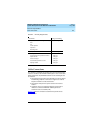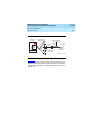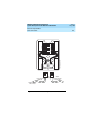
DEFINITY AUDIX System Release 4.0
System Description Pocket Reference
585-300-214
Issue 1
May 1999
Transition Notes
A-6
Switch Integration
Switch Integration
In most switches, the DEFINITY AUDIX system operates in a mode
called
display set
integration. In display set integration, the DEFINITY
AUDIX system communicates with subscribers’ telephones to perform
such actions as lighting MWIs and recording callers’ names and
extensions. The four main chapters of this book focus solely on display
set integration.
The DEFINITY AUDIX system can, however, communicate with the
switch in another mode, called
control link
integration. In control link
integration mode, the DEFNITY AUDIX system connects to a Processor
Interface (PI) or a Processor Gateway (PGATE) circuit pack in the switch.
When the DEFINITY AUDIX system integrates with the switch in control
link mode, the system communicates directly with the switch, rather than
subscribers’ telephones. The switch, for example, lights subscribers’
MWIs when they have AUDIX messages, and it can route calls away
from a DEFINITY AUDIX port that is busy. Control link integration
streamlines the DEFINITY AUDIX system’s interactions with the switch,
so the system can operate faster and more efficiently.
DCS Networking
Control link integration allows the DEFINTY AUDIX system to operate
seamlessly in a Distributed Communication System (DCS) network—a
network of switches that are connected so they act as one switch. In
control link mode, the DEFINTY AUDIX system can support subscribers
on up to 20 remote switches (or
nodes
) in a DCS network as local
subscribers.
Analog Port Emulation
In display set integration, the DEFINITY AUDIX system can emulate two
digital station circuit packs: the TN754 8-port digital circuit pack or the
TN2181 16-port digital circuit pack. In control link integration, the
DEFINTY AUDIX system can also emulate a 16-port analog circuit pack,
the TN746.
Analog port emulation increases system speed and may be less
expensive to install for some customers. However, analog port emulation
is not compatible with some features for digital port emulation, such as
Digital Networking.


















